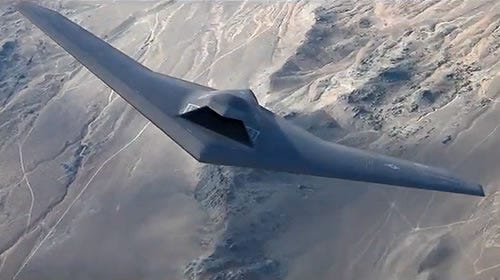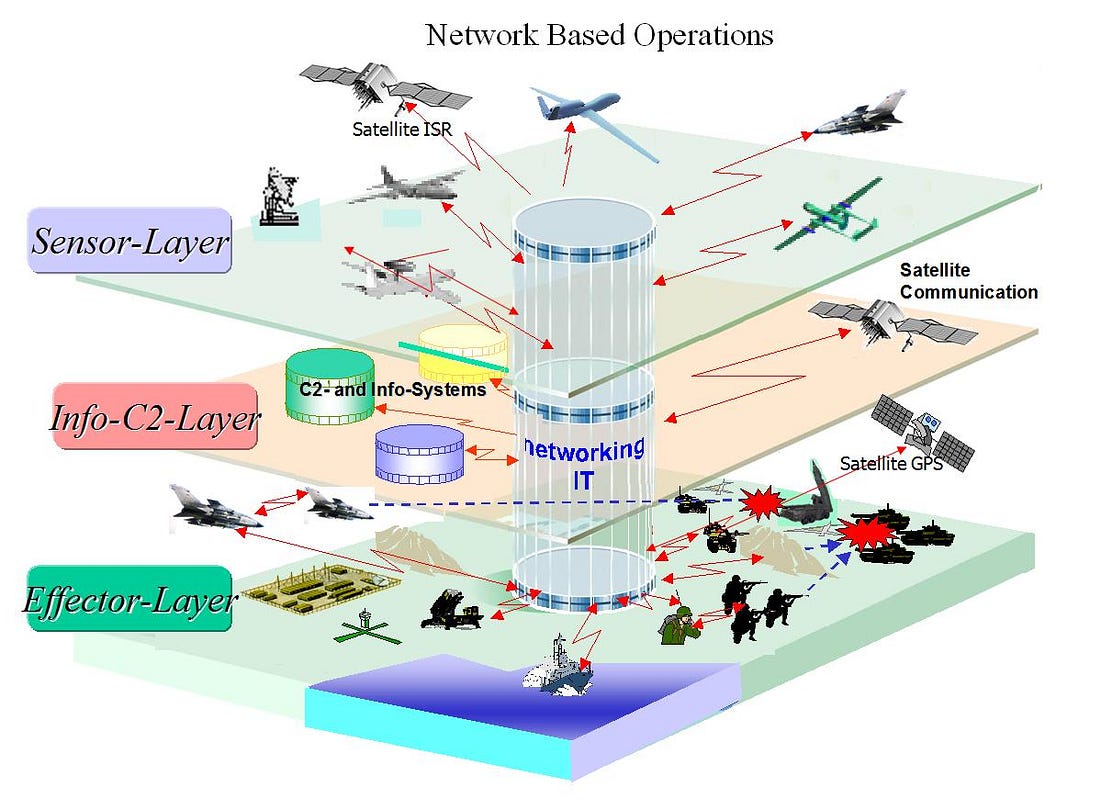Aaron Lapp is a U.S. Air Force officer. The opinions expressed here are his alone, and do not reflect those of the U.S. Air Force, the Department of Defense, or the U.S. Government.
A mid-level Lieutenant Colonel is watching a full-motion video feed from a stealth drone overhead at the Combined Air Operations Center (CAOC). U.S. Soldiers are in a serious firefight, and the Lieutenant Colonel is about to use the information from the feed along with communications from a Joint Terminal Attack Controller on the ground to scramble F-35 fighters to the scene. Before he can give the order, the feed and all communication links go down. “There are troops in contact!” the Lieutenant Colonel yells to no one in particular. “Get that feed back on-line!” As the communications troops begin to work on the equipment, the lights go out. “How can this be happening, now?” the Lieutenant Colonel asks aloud, while silently wondering how to best support the battle and acknowledging that he hasn’t been trained for this.
 UCLASS Drone Concept Design (Lockheed Martin)
UCLASS Drone Concept Design (Lockheed Martin)
The future of war is unpredictable, but one thing is certain-there will be friction and fog. As Barry Watts highlights,“Clausewitzian friction is a basic structural feature of combat interactions between opposing polities.”[1] Human decision-making will cause most of this friction in future wars. Military theorists from Sun Tzu to John Boyd have extolled the virtues of making quick accurate decisions and using misdirection and surprise to interrupt an enemy’s ability to do the same. Making complex decisions is difficult under perfect conditions, because an unpredictable enemy always has a vote. “As Moltke remarked to his aides, the enemy always seemed to have three alternatives open to him and he usually chose the fourth.”[2]
Is the U.S. military currently training its future leaders to make decisions in a constrained information environment or is an over-reliance on technology disrupting this critical leadership ability?
Making correct decisions based upon incomplete or false information is nearly impossible. However, the probability that future military leaders will face this daunting task is very high. Is the U.S. military currently training its future leaders to make decisions in a constrained information environment or is an over-reliance on technology disrupting this critical leadership ability?
The incredible asymmetric information advantage the United States currently enjoys will not last. Emerging competitors, both state and non-state, are developing and fielding technologies designed to diminish this critical advantage. Much of the U.S. operational infrastructure relies on the ability to collect, process, and disseminate information allowing decision makers at headquarters and air operations centers to connect with and direct military forces.
 WWI Soldiers Laying Wire Along a Line of Communications (BBC)
WWI Soldiers Laying Wire Along a Line of Communications (BBC)
The military has long passed orders and information along lines of communications. “The problem of commanding and controlling armed forces, and of instituting effective communications with and within them, is as old as war itself.”[3] Now, these military lines of communications run via the mediums of cyber and space networks whose vulnerabilities are exposed daily. English naval theorist Julian Corbett’s thoughts on sea control indirectly apply to the ability to control information and leverage it for advantage in a future fight, but the enemy can also disrupt them. Depending upon the availability and reliability of this information is a serious mistake for future leaders. They need to develop the ability to operate without the current level of situational awareness.
Further, the U.S. military needs to assess if it is effectively producing people that can lead in this environment. A simple analogy (and possible reality) to this disruption in information is the ability to lead with the lights off. When the power goes out, dispersed units will have little to no ability to communicate with their headquarters, and enemy weapons from an electromagnetic pulse to an advanced cyber denial of service attack could make this situation a reality.
Military exercises often make note of this threat and pay lip service to it, but few put it into actual practice. Exercising without communications and detailed plans is considered too risky for the training environment. The reason for this is simple; the current joint American way of battle has become extremely complex. Expert soldiers, sailors, and airmen get it wrong in training even when all systems are operational.
Degrade these systems and often only the most experienced operators are able to work through it. This can create dangerous situations in training, but by not forcing these lessons upon junior military leaders, the U.S. military takes a higher risk in the long term. People start to expect that their systems will work properly, and are temporarily paralyzed when they do not. Thereby imposing self-induced friction.
The U.S. military… must do more to reinforce to young warfighters that their information systems may prove incredibly fragile in future war scenarios.
The U.S. military does incorporate some of these considerations already, but it must do more to reinforce to young warfighters that their information systems may prove incredibly fragile in future war scenarios. It is true that military leaders are adaptable and will likely work around most system failures, but when quick decisions are required the practiced leader will respond much better.
The only way to prepare for this type of environment is to practice in it. Shut off the lights, turn off the computers, cut the Reaper, Link-16, and Blue Force Tracker feeds and then practice the art of command. If it is deemed too risky to do these things during large-scale joint exercises, then the place to start is the professional military education (PME) system.
Advanced simulation tools replicating limited information decision scenarios can help prepare future leaders for these situations. I am not advocating for another useless tabletop exercise. The military needs to build innovative and flexible leaders across all ranks by teaching them how to independently think through difficult problems. There are many ways to do this including a well-rounded strategic education, encouraging red team type analysis, and testing future leaders with high-end war gaming exercises. All of these should focus on making decisions in an information constrained environment. Developing and then practicing this perishable skill is critical.
The U.S. military doesn’t need another technical gadget for enhanced situational awareness, it needs to properly train decision makers.

A battlefield genius. Napoleon commands from atop his horse. (Wikimedia Commons)
Successful past military leaders have demonstrated this ability to make difficult battlefield decisions with limited information. Some call this genius, others coup d’oeil, but all agree that developing it is difficult, yet possible. Noted strategist Harold Winton argues that a strong professional military education system is critical to inculcating this trait in future military strategists, but only if “it is inspired by a genuine search for creative answers to the enduring questions of military art and science, and if it demands that the proposed answers meet the tests of logic and evidence.”[4] The visionary well-educated military strategist must combine history with theory to probabilistically envision war’s future requirements then practice creating advantage in those conditions. The U.S. military doesn’t need another technical gadget for enhanced situational awareness, it needs to properly train decision makers.
 Concept of Network Based Operations — Building Situational Awareness on the Battlefield
Concept of Network Based Operations — Building Situational Awareness on the Battlefield
The U.S. military’s current use of new technologies to aid decision making are laudable, and indeed necessary in some situations, but it seems that too many officers are becoming reliant upon them for the type of insight previously attributed to a military leader. Unfortunately, this is almost required due to the complex characteristics of the American way of war. The U.S. military must begin by training its officers to operate with minimal information, and then encourage them to simplify things at the tactical, operational, and strategic level. Complex operational methods that depend upon high levels of situational awareness present more risk during training and will likely lead to disaster when the lights go out.
[1] Barry D. Watts, Clausewitzian Friction and Future War, McNair Paper 68 (DIANE Publishing, 1996), http://www.clausewitz.com/readings/Watts-Friction3.pdf, v.
[2] Martin Van Creveld, Command in War (Cambridge (Mass.); London: Harvard University Press, 1985), 8.
[3] Van Creveld, Command in War, 1.
[4] Harold R. Winton and David R. Mets, The Challenge of Change: Military Institutions and New Realities, 1918–1941 (Lincoln: University of Nebraska, 2000), xv.
No comments:
Post a Comment